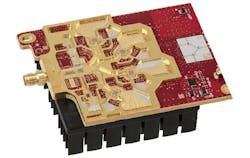The Infiniium UXR series real-time oscilloscopes (Fig. 1) recently unveiled by Keysight Technologies deliver 110-GHz bandwidth that intended for high-speed serial applications. Their ability to capture data at 256 Gsamples/s addresses the latest 5G, optical, and PAM4-based developments. The scopes come in two- or four-channel versions, supporting bandwidths from 80 to 110 GHz. The systems, which can be used to test coherent optical receivers, reduce the timing error of dual-polarization coherent modulation.
1. The Infiniium UXR series handles bandwidths up to 110 GHz with sample rates reaching 256 Gsamples/s.
The oscilloscopes employ 10-bit ADCs that deliver 6.8 effective-number-of-bit (ENOB) performance with an ultra-low noise floor of 210 μVRMS. Systems can be equipped with memory sufficient to capture up to 2-Gsample points.
Design challenges to deliver these systems were solved with custom designs such as the front-end module for the 110-GHz models (Fig. 2). Keysight designed the front-end module using custom ASICs and Keysight-proprietary indium-phosphide (InP) technology. The probes require 256 wirebonds and include a proprietary 110-GHz attenuator implementation. Each channel has a dedicated board with four custom analog-to-digital converter (ADC) ASICs, four data processors, and memory. The board supports one 110-GHz or two 33-GHz channels.
2. Keysight designed and implemented its 110-GHz front-end module using custom ASICs and its proprietary indium-phosphide (InP) technology.
The system can deliver a 2.6% EVM (error vector magnitude) for a 64-Gbaud, 256-QAM (quadrature amplitude modulation) signal running at 1 Tb/s. This is a key factor in being able to view the 256-QAM constellation being employed in high-speed optical transmissions. Previously, the top system was capable of 4.5% EVM.
Developers can also purchase a self-calibration module with the AutoProve III, providing on-site calibration to factory standards. The step generator is traceable to NIST standards. The advantage is that calibration is done in field conditions.
The systems are compatible with Keysight’s Infiniium software used on the S-, V-, and Z-series oscilloscopes. Current Infiniium applications will also work on the UXR, including remote command capabilities. Existing probes are supported as well. Lower-bandwidth versions are upgradable to the top-end 110-GHz performance.
Developers working on optical systems can add the 110-GHz N4391B Optical Modulation Analyzer (OMA) front end that works with Keysight’s VSA-based optical modulation software for end-to-end solution.
The company also released the M8194A 120-Gsample/s arbitrary waveform generator (AWG). The AWG offers stimulus performance for generating formats such as 64-Gbaud, 64-QAM as well as other wideband modulation schemes.



